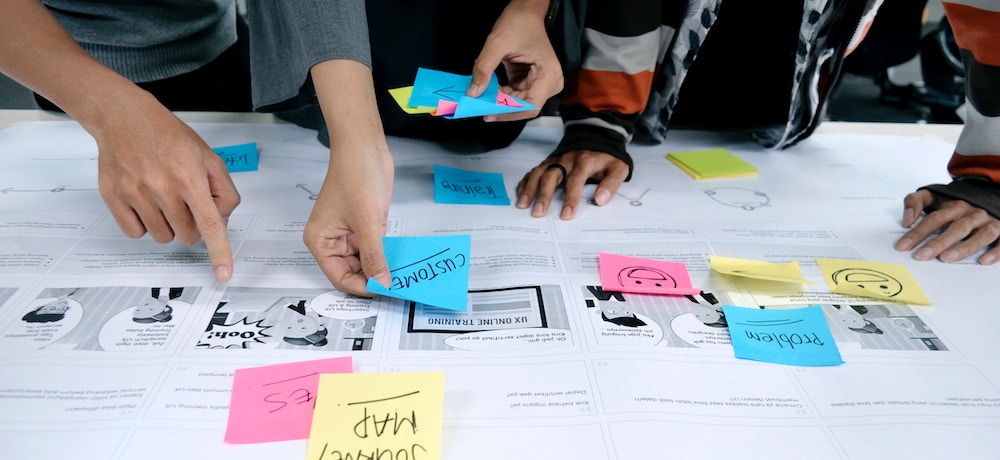User Interface (UI) Vs User Experience (UX) Design: Key Differences
User interface (UI) design is essentially a subset of user experience (UX) design, focusing primarily on the visual elements in a digital product. UX design takes into account the entire user journey and all aspects of their experience and touchpoints, which includes UI design, but also includes customer service experience, product functionality and use experience, post-sales services, marketing communications, sales communications etc.
Let’s delve into more detailed points of differences between user interface (UI) design and user experience (UX) design:
1. Focus
UI design primarily focuses on the visual aspects and presentation of the product in terms of UI elements. It deals with designing elements such as colors, typography, icons, buttons, and other visual components that users interact with directly.
UX design is a more comprehensive discipline, focusing on the overall experience of a product or service throughout the entire user journey. It includes user research, information architecture, usability, and the emotional impact of the product.
2. Responsibilities:
UI design is responsible for creating an aesthetically pleasing and consistent look and feel for the user interface. They execute the overall design style, ensuring that the interface is visually engaging and aligns with the brand’s design guidelines.
UX design is responsible for creating a seamless and enjoyable overall experience for users. They consider the entire user journey, from initial awareness through interaction and post-interaction phases.
3. Tools and Skills
UI design commonly uses graphic design tools like Adobe XD, Sketch, or Figma to create visual assets and layouts. Proficiency in graphic design, color theory, and a keen eye for aesthetics are crucial skills for UI designers.
UX design uses tools for wireframing, prototyping, and testing, such as Axure, Balsamiq, or usability testing platforms. Skills include user research, information architecture, usability testing, and a deep understanding of user behaviors and psychology.
4. Success Metrics
Success in UI design is often measured by visual appeal, adherence to design principles, and consistency across the interface.
Success in UX design is measured by user satisfaction, task efficiency, and whether the product meets user needs and expectations.
UI and UX designers often collaborate closely. While UI focuses on the visual layer, it should align seamlessly with the broader UX strategy to create a cohesive and effective product.
User Interface (UI) and User Experience (UX) Design: Key Similarities
While User Interface (UI) Design and User Experience (UX) Design have distinct focuses and responsibilities, there are key similarities that highlight their interconnected nature in creating a successful product:
- User-Centric Approach:
- UI: Ensures that the visual elements are designed with the user in mind, considering preferences and expectations.
- UX: Puts the user at the center of the design process, aiming to meet user needs, goals, and expectations throughout the entire experience.
- Collaboration:
- UI: Often collaborates closely with UX designers to ensure that the visual elements align with the overall user experience strategy.
- UX: Collaborates with UI designers to integrate visually appealing elements that enhance the overall user experience.
- Iterative Design:
- UI: Involves an iterative design process to refine and improve visual elements based on feedback and testing.
- UX: Embraces an iterative approach, continuously refining the overall user experience based on user feedback and evolving requirements.
- Usability:
- UI: Focuses on creating interfaces that are visually clear and easy to navigate.
- UX: Prioritizes usability to ensure that the overall experience is intuitive, efficient, and user-friendly.
- Brand Consistency:
- UI: Ensures consistency in visual elements to maintain the brand’s identity across the interface.
- UX: Considers brand consistency in the broader context, ensuring that the overall experience reflects the brand’s values and messaging.
- User Feedback:
- UI: Gathers feedback on visual elements through testing and user evaluations.
- UX: Actively seeks user feedback on the entire experience, incorporating insights into the design process.
- Prototyping:
- UI: Involves prototyping visual elements to visualize the final design and gather feedback.
- UX: Uses prototypes to test the overall user journey, including visual elements, interactions, and usability.
- Emotional Impact:
- UI: Aims to create visually appealing elements that evoke positive emotions.
- UX: Considers the emotional impact of the overall experience, aiming for a positive and satisfying emotional response from users.
The similarities between UI and UX design highlight their collaborative nature and shared goal of creating a product that not only looks visually appealing but also delivers a seamless and satisfying user experience. The effective integration of both disciplines is crucial for the overall success of a digital product.




